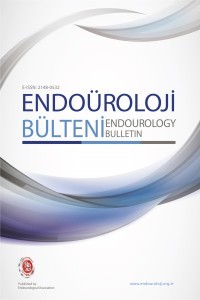Genç populasyonda mesane tümörlerinin klinik ve patolojik özellikleri
Clinical and pathological features of bladder tumors in the young population
___
- 1. Antoni S, Ferlay J, Soerjomataram I, Znaor A, Jemal A, Bray F. Bladder cancer incidence and mortality: a global overview and recent trends. Eur Urol 2017;71:96-108.
- 2. Ferlay J. GLOBOCAN 2012. Estimated cancer incidence, mortality and prevalence worldwide in 2012.
- 3. Howlader N, Noone AM, Krapcho M, et al. SEER Cancer Statistics Review, Bladder Section, 1975‑2008. Bethesda, MD: National Cancer Institute; 1975‑2008.
- 4. Wen YC, Kuo JY, Chen KK, et al. Urothelial carcinoma of the urinary bladder in young adults-Clinical experience at Taipei Veterans General Hospital. J Chin Med Assoc 2005;68:272‑5.
- 5. J. A.Witjes and K.Hendricksen. Intravesical pharmacotherapy for non-muscle-invasive bladder cancer: a critical analysis of currently available drugs, treatment schedules, and long-term results. European Urology 2008;53:45-52.
- 6. Na SW, Yu SH, Kim KH, et al. The prognosis of patients less than 40 years with bladder cancer. J Cancer Res Ther 2014;10:710-14.
- 7. M. Nomikos, A. Pappas, M.-E. Kopaka et al. Urothelial carcinoma of the urinary bladder in young adults: presentation, clinical behavior and outcome. Adv Urol 2011;2011:480738.
- 8. E. Comperat, S. Larre, M. Roupret et al. Clinicopathological characteristics of urothelial bladder cancer in patients less than 40 years old. Virchows Archiv 2015;466,5: 589–594.
- 9. S. Poletajew, M. Walędziak, Ł. Fus. Urothelial bladder carcinoma in young patients is characterized by a relatively good prognosis. Upsala Journal of Medical Sciences 2012;117,1:47–51.
- 10. B. Gunlusoy, Y. Ceylan, T. Degirmenci et al. Urothelial bladder cancer in young adults: diagnosis, treatment and clinical behaviour. Can Urol Assoc 2015;9,9-10:727-730.
- 11. H.Huang,M. Sun, X. Li, and J. Jin. Urothelial carcinoma of the bladder in patients aged 30 years or younger: clinicopathological analysis and expression of fibroblast growth factor receptor 3 (FGFR3) of 45 cases. Medical Oncology 2015;32,5: article 137.
- 12. QH Wang, ZG Ji, HZ Li et al. Clinicopathologic comparison of urothelial bladder carcinoma in young and elder patients. Pathology and Oncology Research 2016;22,1:67-70.
- 13. Turkeri L, Mangır N, Gunlusoy B, et al. Identification of patients with microscopic hematuria who are at greater risk for the presence of bladder tumors using a dedicated questionnaire and point of care urine test - a study by the members of association of urooncology, Turkey. Asian Pac J Cancer Prev 2014;15:6283-6.
- 14. Ozbey I, Aksoy Y, Bicgi O, Polat O, Okyar G. Transitional cell carcinoma of the bladder in patients under 40 years of age. Int Urol Nephrol 1999;31:655-59.
- 15. Shi B, Zhang K, Zhang J, Chen J, Zhang N, Xu Z. Relationship between patient age and superficial transitional cell carcinoma characteristics. Urology 2008;71:1186-90.
- 16. Aben KK, Kiemeney LA. Epidemiology of bladder cancer. Eur Urol 1999;36:660-72.
- 17. Brauers A, Jakse G. Epidemiology and bilogy of human urinary bladder cancer. J Cancer Res Clin Oncol 2000;126:575-83.
- 18. Cohen SM, Shirai T, Steineck G. Epidemiology and etiology premalignant and malignant urothelial changes. Scand J Urol Nephrol Suppl 2000;205:105-12.
- 19. Cheng L, Weaver AL, Leibovich BC, et al. Predicting the survival of bladder carcinoma patients treated with radical cystectomy. Cancer 2000;88:2326-32.
- 20. A. Otunctemur, I. Koklu, E. Ozbek et al. Are bladder neoplasms more aggresive in patients with a smoking-related second malignancy?. Asian Pac J Cancer P 2014;15,9:4025-4028.
- 21. ND Freedman, DT Silverman, AR Hollenbeck, A Schatzkin, CC Abnet. Association between smoking and risk of bladder cancer amongmen and women. JAMA 2011;306,7:737-745.
- 22. GP Paner, P Zehnder, AM Amin, AN Husain, MM Desai. Urothelial neoplasms of the urinary bladder occurring in young adult and pediatric patients: a comprehensive review of literature with implications for patient management. Adv Anat Pathol 2011;18,1:79-89.
- 23. Alabdulkareem AI, Al-Jahdali FH, Nazers AI, Alkhateeb SS. Characteristics of bladder neoplasms in the young population of Saudi Arabia. Urol Ann. 2017;9(4):343‐347.
- 24. Yossepowitch O, Dalbagni G. Transitional cell carcinoma of the bladder in young adults: presentation, natural history and outcome. J Urol 2002;168:61-6.
- 25. Murphy WM, Grignon DJ, Perlman EJ. Tumors of the Kidney, Bladder, and Related Urinary Structures. Washington, DC: American Registry of Pathology; 2004. p. 394.
- 26. Ackerman LV, Rosai J. Surgical Pathology. 5. Saint Louis: C. V. Mosby Company; 1974. Soft tissues; pp. 1146–1147.
- 27. Shapiro E, Strother D. Pediatric genitourinary rhabdomyosarcoma. J Urol. 1992;148:1761–1768. doi: 10.1016/S0022-5347(17)37023-4.
- 28. Grignon DJ. Neoplasms of the urinary bladder. In: Bostwick DG, Eble JN, editors. Urologic surgical pathology. St. Louis: Mosby-Year Book, Inc; 1997. pp. 214–305.
- Yayın Aralığı: Yılda 3 Sayı
- Başlangıç: 2020
- Yayıncı: ENDOÜROLOJİ DERNEĞİ
Thulium Lazer ile Prostat Enükleasyonu(ThuLEP) deneyimleri
Eymen GAZEL, Mehmet YILMAZ, Halil Çağrı AYBAL, Engin KAYA, Serdar YALÇIN, Sercan YILMAZ, Onur AÇIKGÖZ, Lütfi TUNÇ
Laparoskopik nefrektomide spesmen çıkarma yönteminin hasta memnuniyetine etkisi
Serkan DOĞAN, Bülent ÇELİK, Mehmet YILMAZ
Endoskopik Kombine İntrarenal Cerrahi
Emre KARABAY, Nejdet KARŞIYAKALI, Kemal KAYAR, Levent VERİM, Çağatay TOSUN, Ömer YÜCEBAŞ
İlker ŞEÇKİNER, Ali Erdem YILMAZ, Mehmet ÖZTÜRK
Bahadır TOPUZ, Sercan YILMAZ, Serdar YALÇIN, Sanan ASGARLI, Engin KAYA, Murat ZOR, Mesut GÜRDAL, Selahattin BEDİR
Genç populasyonda mesane tümörlerinin klinik ve patolojik özellikleri
Sercan YILMAZ, Ali YILDIZ, Serdar YALÇIN, Can SİCİMLİ, Ali Fuat ÇİÇEK, Bahadır TOPUZ, Selahattin BEDİR
Arif AYDIN, Gökhan ECER, Muzaffer KILINÇ, Mehmet BALASAR, Nurullah ALTINKAYA, Hakan TAŞKAPU, Mehmet Giray SÖNMEZ
Endoskopik Taş Tedavisinde Gelecekte Bizleri Ne Bekliyor?
Fatih SANDIKÇI, Burhan BAYLAN, Abdurrahim İMAMOĞLU
Retzius Koruyucu Robot Yardımlı Laparoskopik Radikal Prostatektomi
